Written by Tracy Dion and originally published in ‘Catnip Chronicles,’ March 2012.
Since the 2007 chemical poisoning that killed over 8,500 cats and dogs and resulted in a massive pet food recall, pet owners have been looking more closely at what they feed their beloved cats and dogs.
Websites have sprung up discussing the topic in great detail; some written by veterinarians, many by individuals who lost pets from contaminated foods in 2007 and since.
One of the diets receiving increasing scrutiny and fast-growing support is raw feeding. Advocates are, in some cases, nearly rabid in their praise and defense of the various raw-feeding methods.
Why is this one diet receiving so much attention?
It’s what the cat is uniquely, specifically, beautifully designed to eat.
Proper nutrition is the building block upon which a body’s health is built, and this applies doubly so to obligate carnivores, whose dietary needs are very sharply defined. Like birds of prey, snakes and sharks, cats are designed inside and out to catch and eat whole prey. Every aspect of the cat’s physiology demonstrates that obtaining what it needs to achieve optimum health – not just survive but truly thrive – depends upon fulfilling its fresh, prey-based dietary requirements.
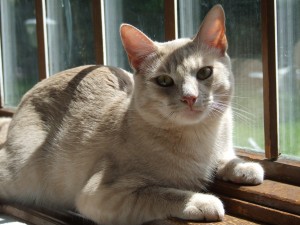
From their sharp eyesight, keen hearing and fearsome claws and teeth, to their exceptional stalking, pouncing and sprinting abilities, the cat’s body is built to hunt. Apex predators in nearly every environment they occupy, they are one of nature’s most perfectly designed killing machines.
They are so well designed, in fact, there has been virtually no genetic drift in the 10,000 years since the African Wild Cat ancestors of today’s house-cats were brought out of the Middle Eastern deserts. That tabby purring so contentedly on your lap is virtually indistinguishable, at the genetic level, from today’s African Wild Cat(1).
As efficient a predator as they are outwardly, the cats’ digestive physiology is even more specialized around their prey-based dietary needs.
Starting at the very basic digestive level, a meal that includes large amounts of animal protein causes an increased flow of saliva, as well as production of the most effective combination of digestive enzymes in that saliva. Similarly, the stomach, gall bladder, pancreas, and upper and lower intestines all secrete a mix of enzymes that are positively responsive to the presence of large amounts of animal protein, ensuring a high level of digestive efficacy throughout the entire digestive tract. Animal tissues, bones and organs are chemically broken down and assimilated at an extremely high level of efficiency and thoroughness, providing the cat with maximal nutrients while expending minimal energy(2). Cats fed standard commercial diets must expend more energy to digest their foods less thoroughly, and do not enjoy the smaller and less frequent stools of raw-fed cats.
More importantly, cats metabolize animal protein and fat directly for their energy. Protein is used for daily body repair and building as well as energy, and calories from protein are either used or excreted. Comparatively-speaking, cats requires a fairly high level of fat in their diet – about 20% – and that, too, is thoroughly and efficiently utilized. You will seldom encounter an overweight cat on a balanced raw diet.
Conversely, cats have no dietary need for carbohydrates and have actually lost some of the enzymatic pathways needed to process them; since there is no pathway for energy conversion, carbs are processed and stored as fat. A carb-heavy diet will stress the cat’s digestive system and reduce the efficiency of protein absorption. If the diet does not contain enough animal protein for their daily needs, or they are unable to process an adequate amount of that protein, cats will sabotage the muscles in their own bodies to obtain their daily needs(3). Additionally, feline satiety is signaled by the ingestion of sufficient amounts of animal protein in their food; lacking it, they will consistently overeat, resulting in yet more carbs being converted to fat.
Furthermore, because the following nutrients are found so abundantly in the bodies of their prey, cats – unlike most animals – are unable to synthesize them and must get their daily requirements from their diet:
• Eleven different amino acids: arginine, histidine, isoleucine, leucine, lysine, methionine, phenylalanine, threonine, tyrptophan, valine, and, of course, taurine.
• Vitamins A and D.
• Niacin. (Although cats can create this to some degree, the amount is insufficient to their needs and they must consume it daily.)
• The fatty acid Arachadonic.
What about pathogens?
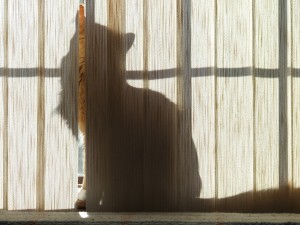 It is a basic premise of natural science that cats, like all animals, are born with the tools and conditions necessary to maintain their health. In this case, they have evolved a natural and effective defense against the bacteria found in their foods and environment. It starts with a salivary enzyme called lysozyme that attacks bacteria and other pathogens in their food, and can even neutralize bacteria on their fur during grooming.
It is a basic premise of natural science that cats, like all animals, are born with the tools and conditions necessary to maintain their health. In this case, they have evolved a natural and effective defense against the bacteria found in their foods and environment. It starts with a salivary enzyme called lysozyme that attacks bacteria and other pathogens in their food, and can even neutralize bacteria on their fur during grooming.
Bacteria that make it past the mouth hit an extremely acidic stomach that contains hydrochloric acid and several digestive enzymes; an environment highly inimical to those pathogens. Once past the stomach and into the small intestine, bacteria encounter additional obstacles, including strong antimicrobial agents in the form of bile salts from the liver. The pancreas secretes more enzymes as well as bicarbonate, which breaks down the cell walls of invading bacteria.
After the small intestine, digestive matter passes through the large intestine, where high levels of beneficial bacteria flourish. This natural intestinal flora competes with any surviving pathogens for resources, preventing them from taking hold and forcing them out of the body. Lysozyme, the initial gate-keeper, is also present throughout the digestive tract and is expelled right along with the cat’s waste(2).
All of this happens fairly quickly, disallowing pathogens time to multiply. Comparatively-speaking, cats have one of the shortest digestive tracts in the animal kingdom. Their body length-to-digestive tract ratio is only 1:4, compared to 1:6 for the dog (and us!), and 1:20 for the cow. Animal-based meals take on average only 12 hours to pass completely through.
In fact, the cat’s body is so efficient at managing bacteria that some experts estimate it destroys about 98% of the pathogens it ingests(4). 98%! That’s as effective as America’s most popular cleaning solutions!
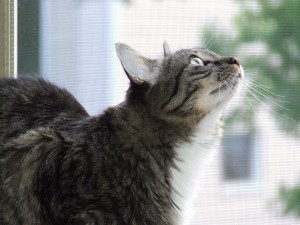
In summary, there is an intimate relationship between the cat’s natural diet and the animal’s intestinal characteristics, and what a cat eats affects how that food is digested. From the greater amount and more efficient composition of saliva secreted during the meal to the increased activity of stomach and intestinal enzymes and other digestive secretions to the increased speed at which food is moved through the digestive tract, high animal-protein / high moisture diets have a salubrious effect. Eating such a diet is not only good for the cat from a nutritional perspective – it causes a chain reaction of chemical events that actively increases the cat’s ability to pull maximum nutrition from the food while bolstering the animal’s natural defenses against pathogens.
Well, ok, but my cats are doing fine on kibble and / or canned foods.
All cats look “fine,” until they don’t. I submit that most, if not all, kibble and canned fed cats are not feeling as well as they could; they are not truly *thriving.* Cats are particularly good at hiding when they aren’t feeling well, and their reputation for being lay-abouts works against them in this respect. I have been working with cat owners transitioning their cats to raw diets for a while now and the one most remarked upon change is *always* the extraordinary leap in energy and vitality their cats exhibit when fed a properly balanced raw diet. (Improved coat quality, sociability, general oral health and breath odor, and a large reduction in stool quantity and odor are also regularly seen improvements.)
The pet food industry serves, in large part, as the dumping ground for human food and agricultural industries. Dead, diseased, dying, disabled and drugged animals are fodder for the rendering vats, as are barrels of restaurant grease and food waste and truck loads of expired products from grocery stores (packages and all). Pet food products containing “meat meal,” “meat and bone meal,” and “poultry meal” are very likely to contain less-than-optimally nutritious ingredients common pet owners would find very objectionable, were they aware(5).
Kibble and canned products are cooked down to the point of being virtually nutritionally inert. Additives are mixed in to give the foods flavor, texture and form, and to prevent spoilage. Foods that have no business in an obligate carnivore’s diet are added for a variety of reasons unrelated to the cat’s health, including profit and marketing effect. A mix of vitamins and minerals is added to give the food some nutritional value – a mix that is inherently incomplete because science has not yet identified all the nutrients cats get from their prey, nor in what combinations those nutrients are utilized by the cat’s body. Quality control can be iffy and recalls, sometimes involving deaths, happen every few years for a myriad of reasons, including chemical contaminants, unhealthy or poisonous additives, and unbalanced vitamin / mineral mixes (mixes which are different for every manufacturer).
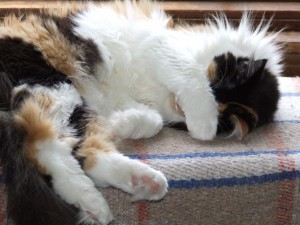 Kibble is a singularly inappropriate “food” product for cats. Because of the very nature of their manufacture, kibble requires some form of carbohydrate content. Many of them are loaded with grains, while others have substituted potatoes or another starch – seemingly more benign, but in reality still a “food” the cat’s body is ill-equipped to process.
Kibble is a singularly inappropriate “food” product for cats. Because of the very nature of their manufacture, kibble requires some form of carbohydrate content. Many of them are loaded with grains, while others have substituted potatoes or another starch – seemingly more benign, but in reality still a “food” the cat’s body is ill-equipped to process.
Worst of all, being forced to process such a foreign diet stresses the cat’s body enormously. That, combined with a chronically dehydrated state of being – as desert animal descendants, cats have a low thirst drive and an inefficient method of drinking water (their lapping mechanics are not the same as a dog’s) – and kibble is potentially the single largest underlying cause of many of the diseases and other illnesses sweeping in epidemic proportions across our domestic cat populations. Obesity, diabetes, urinary tract issues, inflammatory bowel disease (often a precursor for intestinal cancer, or lymphoma), kidney disease, allergies, vomiting and diarrhea are just a few of the ailments that have been linked in some manner to kibble-laden diets.
As Dr. Elizabeth Hodgkins, author of YourDiabeticCat.com, says in her book, Your Cat: Simple New Secrets to a Longer, Stronger Life, “I have never seen a single case of serious obesity, diabetes, urinary tract disease, or IBD in a cat fed meat instead of commercial dry foods. Many other people have seen the same results. Further, I do not see nutritional deficiencies in cats fed properly balanced raw-meat diets. I want to emphasize a point here. The incidence of these problems has not just declined on a raw-meat diet, they have entirely disappeared. These results are too dramatic to ignore.”
Either because they are nutritionally deficient, because the additives are harmful in some manner, or a combination of both, even cats being fed what most regard as the healthiest of canned food products exhibit unmistakable signs of improved vitality and health when transitioned to a balanced raw diet.
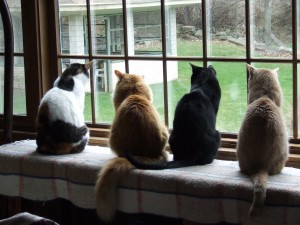 Conclusion
Conclusion
Evolution, science and logic all point to a fresh raw prey-based diet as being the most appropriate, nutritious, and easily-digestible diet for today’s cats, and the anecdotal evidence is overwhelmingly in favor of raw diets. With the increased scrutiny being given to what America’s pet owners feed their littlest family members, it’s easy to foresee a time when they will consider feeding raw products to cats and dogs as common-sense healthy as we do giving whole, fresh foods to our kids. Not everyone eats or serves whole apples over the fast-food apple Danish, but there is no doubt in our minds which of the two is healthier.
– – – – – – – – – – – – – – – – – – – – – – – – – – – – – – – – – – – – – – – – – – – – – – – – – – – – – – – – – – – – – – – – – – – – – – – – – – – – – – – – – – – –
1. Carlos A. Drisco, et. al, (June, 2007), The Near Eastern Origin of Cat Domestication, Science Express
2. National Research Council (U.S.), (2006), The Nutrient requirements of dogs and cats, National Research Council Ad Hoc Committee on Dog and Cat Nutrition, Chapter One
3. Mark A. Peterson, DVM, (December, 2011), Can Increasing the Amount of Fat or Carbohydrate in a Cat’s Diet Compensate for Low Protein Intake?, Insights into Veterinarian Endocrinology
4. Celest A. Yarnell, Ph.D., (September, 2011), Celestial Homemade Food for Cats, Care2 Make a Difference
5. Feline Nutrition Education Society
If you enjoyed this article or found it informative, please “Like” it, “Tweet” it, or share it using any of the buttons below. And don’t forget to check out our FB page, join the discussions in our awesome FB group and follow us on Twitter!
Created 01/23/12; Updated 08/11/14

